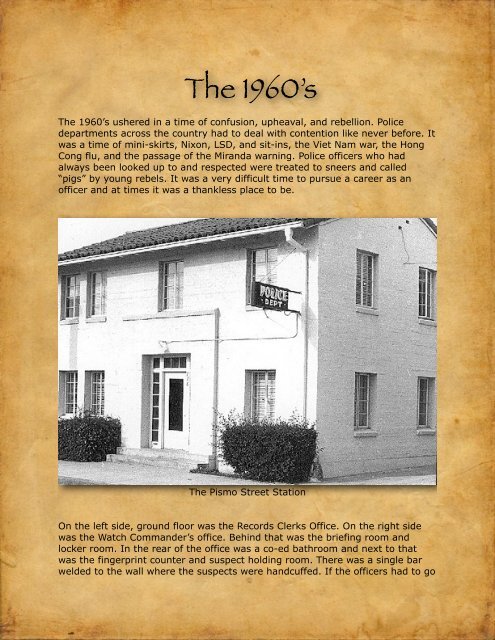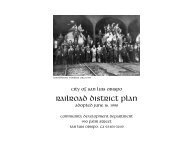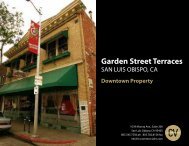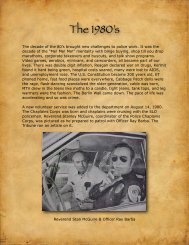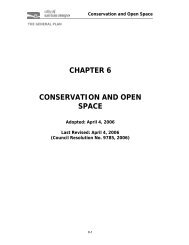The 1960's - the City of San Luis Obispo
The 1960's - the City of San Luis Obispo
The 1960's - the City of San Luis Obispo
Create successful ePaper yourself
Turn your PDF publications into a flip-book with our unique Google optimized e-Paper software.
<strong>The</strong> 1960’s<br />
<strong>The</strong> 1960’s ushered in a time <strong>of</strong> confusion, upheaval, and rebellion. Police<br />
departments across <strong>the</strong> country had to deal with contention like never before. It<br />
was a time <strong>of</strong> mini-skirts, Nixon, LSD, and sit-ins, <strong>the</strong> Viet Nam war, <strong>the</strong> Hong<br />
Cong flu, and <strong>the</strong> passage <strong>of</strong> <strong>the</strong> Miranda warning. Police <strong>of</strong>ficers who had<br />
always been looked up to and respected were treated to sneers and called<br />
“pigs” by young rebels. It was a very difficult time to pursue a career as an<br />
<strong>of</strong>ficer and at times it was a thankless place to be.<br />
<strong>The</strong> Pismo Street Station<br />
On <strong>the</strong> left side, ground floor was <strong>the</strong> Records Clerks Office. On <strong>the</strong> right side<br />
was <strong>the</strong> Watch Commander’s <strong>of</strong>fice. Behind that was <strong>the</strong> briefing room and<br />
locker room. In <strong>the</strong> rear <strong>of</strong> <strong>the</strong> <strong>of</strong>fice was a co-ed bathroom and next to that<br />
was <strong>the</strong> fingerprint counter and suspect holding room. <strong>The</strong>re was a single bar<br />
welded to <strong>the</strong> wall where <strong>the</strong> suspects were handcuffed. If <strong>the</strong> <strong>of</strong>ficers had to go
on a call, <strong>the</strong>y doubled handcuffed <strong>the</strong> suspect and had <strong>the</strong> dispatcher keep an<br />
eye on <strong>the</strong>m. On <strong>the</strong> second floor was <strong>the</strong> Chief’s <strong>of</strong>fice, <strong>the</strong> Captain’s <strong>of</strong>fice,<br />
and <strong>the</strong> Detective Division.<br />
<strong>The</strong> Records Clerks<br />
On <strong>the</strong> left is Marge Jordan and on <strong>the</strong> right (?)<br />
On August 15 , 1960, <strong>the</strong> first policewomen were hired in <strong>San</strong> <strong>Luis</strong> <strong>Obispo</strong>. <strong>The</strong><br />
Tribune article was titled “First Policewomen on Parking Meter Duty.”<br />
“Police women as traffic <strong>of</strong>ficers became a reality in <strong>San</strong> <strong>Luis</strong><br />
<strong>Obispo</strong> today. Mrs. Gloria Meyer, 22, is one <strong>of</strong> two women who<br />
joined <strong>the</strong> force today, having completed two weeks <strong>of</strong> training in<br />
Alhambra. <strong>The</strong> o<strong>the</strong>r policewoman is Mrs. Patricia Wray, 27. A<br />
definitely pretty touch was added to <strong>the</strong> downtown scene today to<br />
brighten up <strong>the</strong> drab business <strong>of</strong> handing out parking tickets.<br />
Smiles will be more prominent than <strong>the</strong> usual frowns from
motorists cited for traffic violations with <strong>the</strong> addition to <strong>the</strong> force <strong>of</strong><br />
two attractive young policewomen. <strong>The</strong>y started <strong>the</strong> patrol <strong>of</strong> <strong>the</strong><br />
downtown area this morning. Many o<strong>the</strong>r California cities using<br />
women for parking meter patrol have also noted <strong>the</strong> plan as<br />
efficient and excellent, according to Police Chief William Sch<strong>of</strong>ield,<br />
who inaugurated <strong>the</strong> program for this city. Mrs. Meyer was fully<br />
equipped with <strong>the</strong> especially designed uniform today, while Mrs.<br />
Wray, <strong>the</strong> taller <strong>of</strong> <strong>the</strong> two, required additional alteration to put her<br />
in <strong>the</strong> attractive outfit chosen. Chief Sch<strong>of</strong>ield pointed out that <strong>the</strong><br />
policewomen will always be equipped with small change to aid <strong>the</strong><br />
motorist caught with coins unsuited for meters.<br />
“Temporarily, <strong>the</strong>y will walk <strong>the</strong>ir beats, awaiting <strong>the</strong> arrival <strong>of</strong> parts<br />
to complete <strong>the</strong> scooters which will be <strong>the</strong>ir permanent mounts.<br />
<strong>The</strong> scooters, when put in service, will provide <strong>the</strong> women with<br />
two-way radio communications to <strong>the</strong> police headquarters.<br />
Linda Healy<br />
She left <strong>the</strong> <strong>San</strong> <strong>Luis</strong> <strong>Obispo</strong><br />
Police Department and was<br />
selected to be one <strong>of</strong> 40 women<br />
on CHP. She was one <strong>of</strong> twenty<br />
who were successful while<br />
assigned to East L.A. patrol from<br />
1974-1976. She later went to LA<br />
County Sheriff’s Office and,<br />
promoted through <strong>the</strong> rank <strong>of</strong><br />
Captain. She was assigned as Captain in charge <strong>of</strong> <strong>the</strong> largest<br />
women’s jail in <strong>the</strong> country and <strong>the</strong>n was assigned to a patrol<br />
station serving 250,000 residents. She was promoted to<br />
Commander and retired in 2000 at that rank.
“<strong>The</strong> pay scale established by <strong>the</strong> <strong>City</strong> Council for <strong>the</strong> policewomen<br />
as a starter is $312 a month. <strong>The</strong> Chief pointed out that although<br />
<strong>the</strong> women will be engaged primarily in meter enforcement, <strong>the</strong>y<br />
will also have o<strong>the</strong>r duties and will enforce all parking regulations in<br />
an endeavor to lower traffic congestion downtown. He said <strong>the</strong>ir<br />
presence will also be welcomed as matrons for women and children<br />
in <strong>the</strong> shopping district. <strong>The</strong>ir employment releases two male<br />
<strong>of</strong>ficers for additional traffic duties in outlying areas. Chief Sch<strong>of</strong>ield<br />
observed that <strong>the</strong>re were 467 traffic accidents in <strong>the</strong> city last year,<br />
with 266 <strong>of</strong> <strong>the</strong>m occurring in <strong>the</strong> downtown area.”<br />
Chief Lee Sch<strong>of</strong>ield<br />
On December 17 , 1963, an article appeared in<br />
<strong>the</strong> Tribune regarding <strong>the</strong> need for more <strong>of</strong>ficers<br />
for <strong>the</strong> department.<br />
“<strong>The</strong> <strong>San</strong> <strong>Luis</strong> <strong>Obispo</strong> Police Department<br />
should be beefed up with <strong>the</strong> addition <strong>of</strong> five patrolmen and three<br />
new patrol cars,’ a city consultant recommended to <strong>the</strong> <strong>City</strong><br />
Council. ‘You have a well-organized, well-run department,’ Louis<br />
Kroeger <strong>of</strong> <strong>San</strong> Francisco stated. ‘But our study turned up a<br />
number <strong>of</strong> recommendations which you should consider.’ Among<br />
<strong>the</strong> reports findings:<br />
• That <strong>the</strong> city be divided into three sections for police administration<br />
• That <strong>City</strong> Council should begin planning a building to house police<br />
department facilities
• That <strong>the</strong> city should turn <strong>the</strong> financing <strong>of</strong> policing school children home<br />
from schools and across streets over to <strong>the</strong> school system<br />
“<strong>The</strong> police department study was made after a prolonged hassle<br />
last spring over <strong>the</strong> size <strong>of</strong> <strong>the</strong> department. One city administrator<br />
said it would be adequate to continue to add one patrolman a year.<br />
Police Chief Lee Sch<strong>of</strong>ield said he needed eight men. <strong>The</strong> mayor,<br />
who ran for election which included a promise to enlarge <strong>the</strong><br />
department, said that <strong>the</strong> report, which cost $2,275, finds that<br />
crime is not presently a serious problem in <strong>the</strong> city because <strong>the</strong> city<br />
has a reputation <strong>of</strong> being inhospitable to lawbreakers. He fur<strong>the</strong>r<br />
stated that patrolmen should do <strong>the</strong>ir cruising in marked police cars<br />
and o<strong>the</strong>r police work should be done in unmarked cars.”<br />
Financing <strong>of</strong> <strong>the</strong> school crossing guard service was transferred to <strong>the</strong> school<br />
budget at a savings <strong>of</strong> $12,500. As to <strong>the</strong> building <strong>of</strong> <strong>the</strong> kind proposed, it<br />
would have cost around $50,000, an addition <strong>of</strong> 13 to 14 cents on <strong>the</strong> tax rate<br />
unless made a long range plan.<br />
In February 1964 <strong>the</strong> <strong>City</strong> Council did approve adding five more patrolmen on to<br />
<strong>the</strong> city police force. Adding <strong>the</strong> new men brought <strong>the</strong> total full strength patrol<br />
force to 24, including two detectives. Police Chief William Sch<strong>of</strong>ield was<br />
authorized to employ <strong>the</strong> <strong>of</strong>ficers as soon as possible.<br />
Photo includes:<br />
Tom Gallimore, Larry<br />
Lundsford, and ei<strong>the</strong>r<br />
Lieutenant Elsea or Lieutenant<br />
Morrisey on <strong>the</strong> far right<br />
In 1964 civil unrest was rampant,<br />
especially in <strong>the</strong> cities where large populations <strong>of</strong> college students were housed.<br />
In <strong>San</strong> Francisco, UCSF was in turmoil with sit-ins and protests. Our city was<br />
calm in comparison. On September 1, 1964, an article titled “New Weapon For
Police” was noted. It read as follows and established a precedent to enable<br />
police <strong>of</strong>ficers more control in civil confrontations.<br />
“Police <strong>of</strong>ficers, in making an arrest, are being attacked by<br />
bystanders who ei<strong>the</strong>r seek to prevent that arrest or who want to<br />
vent some unrelated irritation with <strong>the</strong> law. <strong>The</strong>problem became so<br />
serious in <strong>the</strong> <strong>San</strong> Francisco Bay area that Assemblyman Don<br />
Mulford introduced a bill to cope with it. <strong>The</strong> measure becomes law<br />
September 17. As <strong>of</strong> that date, <strong>the</strong> police are going to have a new<br />
weapon on <strong>the</strong>ir side, and <strong>the</strong> hoodlums who want to give <strong>the</strong><br />
police a bad time might as well face up to it. Mulford’s measure<br />
makes it a felony to attack a policeman in <strong>the</strong> performance <strong>of</strong> his<br />
duty. No more <strong>of</strong> this misdemeanor routine. A felony charge is a<br />
tough rap to beat and an even tougher stigma for a young man to<br />
escape once he has been convicted.<br />
“Mulford reports that continued attacks on police (and he was<br />
speaking before <strong>the</strong> riots in <strong>the</strong> Watts area <strong>of</strong> Los Angeles) were<br />
responsible for <strong>the</strong> drastic step taken by <strong>the</strong> legislature to provide<br />
greater protection for law enforcement <strong>of</strong>ficers. He put it this way:<br />
‘I am determined to do everything possible to support <strong>the</strong> police<br />
departments in <strong>the</strong>ir attempt to preserve law and order in our<br />
communities. <strong>The</strong> rule <strong>of</strong> law in our society is an important one and<br />
evidently it is going to take some stiff sentences to <strong>the</strong> state<br />
penitentiary to stop <strong>the</strong>se unprovoked assaults when police are<br />
merely carrying out <strong>the</strong>ir sworn duty.’”<br />
Sergeant Don Englert in front <strong>of</strong> Pismo Street Station. He later<br />
retired as Chief <strong>of</strong> Police in 1987.
Accident at “<strong>The</strong> Big Block”<br />
Range Qualification:<br />
Third from <strong>the</strong> left is Sergeant Morrisey, last on <strong>the</strong> right is Officer Tom Stewart
That year a young <strong>of</strong>ficer was praised for his courage in facing down a man with<br />
a loaded rifle. <strong>The</strong> article read as follows:<br />
“Without regard for his own safety, a young <strong>San</strong> <strong>Luis</strong> <strong>Obispo</strong><br />
policeman faced <strong>the</strong> muzzle <strong>of</strong> a 30.06 Enfield rifle Monday to<br />
disarm and arrest a burglary suspect in <strong>the</strong> Sou<strong>the</strong>rn Pacific<br />
Railroad yard. <strong>The</strong> arrest was made by Patrolman Winston B.<br />
Morrissey, 24, who had responded to a call from a woman who said<br />
a man had just stolen a radio from a neighbor’s house. Booked into<br />
<strong>the</strong> county jail on a charge <strong>of</strong> assault with a deadly weapon against<br />
a police <strong>of</strong>ficer was a 58 year old man from Arkansas.<br />
“<strong>The</strong> chain <strong>of</strong> events began when a man noted a stranger had just entered <strong>the</strong><br />
property <strong>of</strong> a neighbor. His wife went to <strong>the</strong> neighbor’s residence, as her<br />
husband had to leave for work, to investigate as she knew her neighbors were<br />
not at home. Looking in <strong>the</strong> window, she saw a man walking around <strong>the</strong> living<br />
room. She waited until he came out and noticed he was carrying a red radio.<br />
She told <strong>the</strong> man, ‘Get out <strong>of</strong> here!’, <strong>the</strong>n demanded that he give her <strong>the</strong> radio.<br />
He complied and politely said, ‘Bless you lady,’ before walking away. Mrs.<br />
Ludwig called police and patrolman Morrissey arrived a few moments later.<br />
“Heading for <strong>the</strong> railroad tracks, Morrissey spotted <strong>the</strong> suspect about 300 yards<br />
ahead, walking east. <strong>The</strong> <strong>of</strong>ficer shouted but <strong>the</strong> man ducked behind some<br />
sheds momentarily and came into view again. <strong>The</strong> suspect began to run and<br />
Morrissey ran after him for a short distance before <strong>the</strong> man stopped. As <strong>the</strong><br />
suspect turned around to face <strong>the</strong> <strong>of</strong>ficer, Morrissey saw a rifle pointed at him.<br />
<strong>The</strong> patrolman drew his own weapon slowly, demanding he drop <strong>the</strong> rifle. ‘He<br />
kept it pointed at me as I walked toward him,’ Morrissey said. ‘I don’t know why<br />
I did it. He could have shot me any time because <strong>the</strong> gun was loaded; it had a<br />
shell in <strong>the</strong> chamber. <strong>The</strong> thought <strong>of</strong> being killed apparently didn’t enter my<br />
mind. I was thinking only <strong>of</strong> taking <strong>the</strong> rifle away from him. After I had<br />
disarmed him, he <strong>of</strong>fered no resistance and seemed to be reflecting on <strong>the</strong><br />
seriousness <strong>of</strong> <strong>the</strong> situation. I did some reflecting too.’ “Police believe <strong>the</strong><br />
suspect obtained <strong>the</strong> rifle after he left <strong>the</strong> residence he’d broken into, since <strong>the</strong><br />
weapon was later identified as belonging to ano<strong>the</strong>r neighbor nearby.”
Officer Copeland<br />
A reporter conducted an interesting experiment in November 1964. He<br />
wrote his results in <strong>the</strong> Tribune and titled it “Feet May Be Flat, But Mind<br />
Is Sharp.” It reads as follows:<br />
“<strong>The</strong> cop on <strong>the</strong> beat may have flat feet, but he has a sharp<br />
mind—I know. I recently took <strong>the</strong> aptitude test administered<br />
to police candidates in <strong>San</strong> <strong>Luis</strong> <strong>Obispo</strong>. It was difficult. Its<br />
difficulty accounts for <strong>the</strong> failure <strong>of</strong> half <strong>the</strong> 84 candidates who<br />
have taken <strong>the</strong> test since 1961. <strong>The</strong> exam is one <strong>of</strong> <strong>the</strong> major<br />
reasons why approximately 96 out <strong>of</strong> every 100 men who<br />
apply for police <strong>of</strong>ficer positions never put on a uniform in <strong>the</strong><br />
city.<br />
“Passing <strong>the</strong> test is one <strong>of</strong> several requirements which keep<br />
<strong>the</strong> city police force effective—and short <strong>of</strong> men. <strong>The</strong> force is<br />
currently short <strong>of</strong> seven patrolmen. Approximately ¾ <strong>of</strong> <strong>the</strong><br />
police <strong>of</strong>ficer applicants are screened out before <strong>the</strong>y even get<br />
to <strong>the</strong> aptitude test, <strong>San</strong> <strong>Luis</strong> <strong>Obispo</strong> Police Chief William<br />
Sch<strong>of</strong>ield said. If a man fulfills preliminary requirements, he<br />
may take <strong>the</strong> California State Personnel Board Aptitude Test<br />
for Law Enforcement.<br />
“When I took <strong>the</strong> test, 13 candidates (not including myself)<br />
were seated around a table in <strong>City</strong> Hall. Seven passed. <strong>The</strong><br />
test consisted <strong>of</strong> four categories. <strong>The</strong>y were observation and<br />
memory (15 points), judgment for law enforcement (15<br />
points), writing and speaking effectively (25 points), and<br />
analytical and reasoning (45 points). Applicants who passed<br />
<strong>the</strong> test were <strong>the</strong>n given an oral exam and had <strong>the</strong>ir<br />
backgrounds checked before being <strong>of</strong>fered an appointment.<br />
“Although high school graduation was <strong>the</strong> only educational<br />
requirement, <strong>the</strong> testing required a higher degree <strong>of</strong><br />
concentration unusual in <strong>the</strong> high school exams I have taken.
Certainly <strong>the</strong> test seemed more difficult than aptitude exams I<br />
took in <strong>the</strong> US army. Insistence that <strong>the</strong> <strong>of</strong>ficers pass <strong>the</strong><br />
difficult test drastically narrows <strong>the</strong> field <strong>of</strong> available<br />
candidates. It also assures <strong>the</strong> city <strong>of</strong> an intelligent police<br />
force. Apparently <strong>the</strong> only hope for <strong>the</strong> criminal <strong>of</strong> today is a<br />
college education.”<br />
It’s interesting to note that <strong>the</strong> writer <strong>of</strong> this piece never mentioned<br />
whe<strong>the</strong>r he actually passed <strong>the</strong> test!<br />
Evidence Technician<br />
Dick Rayburn<br />
Murder in <strong>the</strong> city was a rare occurrence. On December 7<br />
1968, an article appeared in <strong>the</strong> paper about a homicide that had taken place<br />
as a result <strong>of</strong> domestic violence. Battered wives and spousal abuse were<br />
rarely mentioned back in <strong>the</strong> 60’s and before. Today, <strong>of</strong>ficers are<br />
trained to recognize and understand <strong>the</strong>se issues, but <strong>the</strong>n it was an<br />
unspoken problem, not mentioned in polite society. <strong>The</strong> fact that <strong>the</strong><br />
paper covered it is unusual, perhaps because it had led to <strong>the</strong> desperate<br />
act <strong>of</strong> murder on <strong>the</strong> part <strong>of</strong> <strong>the</strong> battered wife. Or was it self defense?<br />
Only <strong>the</strong> wife truly knew <strong>the</strong> answer to that. It was titled, “Steak Knife<br />
Kills Man; Wife Jailed.”<br />
“A 28 year old <strong>San</strong> <strong>Luis</strong> <strong>Obispo</strong> man was stabbed to death<br />
Friday night and his wife was booked into county jail for<br />
investigation <strong>of</strong> murder. <strong>The</strong> suspect told police <strong>the</strong> incident<br />
was <strong>the</strong> result <strong>of</strong> a family argument. Investigators said <strong>the</strong><br />
man and woman apparently had been quarreling but <strong>the</strong><br />
reason has not yet been determined. Police were called to <strong>the</strong><br />
scene shortly after 6:30 PM and found <strong>the</strong> husband lying on
his back. He had suffered one stab wound in <strong>the</strong> chest. An<br />
eight inch serrated steak knife was found in <strong>the</strong> bushes<br />
nearby. Officers said <strong>the</strong> man apparently died instantly when<br />
<strong>the</strong> knife penetrated his heart. His wife was standing on <strong>the</strong><br />
street with a friend when <strong>of</strong>ficers arrived.<br />
“Although <strong>the</strong> suspect made no statement, two friends <strong>of</strong> <strong>the</strong><br />
couple indicated <strong>the</strong> stabbing resulted from <strong>the</strong> victim’s<br />
alleged mistreatment <strong>of</strong> his wife. <strong>The</strong> suspect called her friend<br />
asking if she could take <strong>the</strong> victim to <strong>the</strong> hospital because ‘he<br />
has been hurt.’ <strong>The</strong> neighbor quoted <strong>the</strong> wife as saying, ‘He<br />
should not have been dragging me. I didn’t cut him bad, just a<br />
little.’<br />
“Detectives said <strong>the</strong> couple had been quarreling in <strong>the</strong>ir home,<br />
but <strong>the</strong> wife walked out <strong>of</strong> <strong>the</strong> house, taking <strong>the</strong> steak knife<br />
with her. She walked around <strong>the</strong> corner <strong>of</strong> her home and<br />
apparently was standing <strong>the</strong>re when her husband reached her<br />
and started <strong>the</strong> argument again, <strong>of</strong>ficers said. <strong>The</strong> wife was<br />
taken into custody and charged with manslaughter.”<br />
<strong>The</strong> outcome <strong>of</strong> this case was not noted in <strong>the</strong> Tribune and <strong>the</strong><br />
disposition is unknown. However, it illustrates <strong>the</strong> issue <strong>of</strong> domestic<br />
violence in <strong>the</strong> past and shows that domestic disputes can turn deadly if<br />
not addressed before <strong>the</strong>y get out <strong>of</strong> hand. Police <strong>of</strong>ficers have a moral,<br />
if not legal, obligation to take each call in this arena seriously as <strong>the</strong><br />
above outcome can occur again if not addressed carefully and proper<br />
referrals made. A recent article mentioned that domestic violence is<br />
now following women into <strong>the</strong> workplace in America and some<br />
companies are putting programs in place to deal with abusive spouses<br />
who come into <strong>the</strong> workplace and assault <strong>the</strong>m <strong>the</strong>re. This may be<br />
ano<strong>the</strong>r place that <strong>of</strong>ficers will be called to intervene.<br />
Some interesting information has been provided by retired Officer Gary<br />
Wilde.<br />
“<strong>The</strong> first Tactical Squad was formed in 1969. It consisted <strong>of</strong><br />
ten <strong>of</strong>ficers, me being one <strong>of</strong> <strong>the</strong>m, and <strong>the</strong>y were <strong>the</strong> only<br />
<strong>of</strong>ficers allowed to carry batons. All <strong>the</strong> training took place in<br />
<strong>the</strong> basement <strong>of</strong> <strong>City</strong> Hall during many evenings. <strong>The</strong> team<br />
was formed because <strong>of</strong> all <strong>the</strong> Vietnam protests at Cal Poly,<br />
<strong>the</strong> opening <strong>of</strong> Diablo Canyon, and <strong>the</strong> riots in Isla Vista in<br />
<strong>San</strong>ta Barbara. We went three nights in a row to Isla Vista,<br />
including <strong>the</strong> night <strong>the</strong> Bank <strong>of</strong> America was burned down<br />
completely. Captain Don Englert was our supervisor and<br />
accompanied us all three nights. Because we were so shorthanded<br />
with <strong>of</strong>ficers, all <strong>the</strong> detectives had to put on <strong>the</strong>ir<br />
police <strong>of</strong>ficer uniforms and patrol <strong>the</strong> streets <strong>of</strong> <strong>San</strong> <strong>Luis</strong>.<br />
“Interesting but true - When I hired in January 1968, our<br />
radio system was so poor that if a police unit went south on<br />
US 101 past <strong>the</strong> Los Osos Valley Road over-pass, we would
literally have to put a police unit on top <strong>of</strong> <strong>the</strong> overpass to<br />
transmit to <strong>the</strong> southbound unit, <strong>the</strong>n back to <strong>the</strong> police<br />
department on Pismo Street. If you reached <strong>the</strong> curve by<br />
Ontario Grade (now <strong>the</strong> Avila Beach turn-<strong>of</strong>f), you lost total communications<br />
with anyone. Every south county police<br />
agency was on a different radio frequency.<br />
“In 1968-69, if you needed a back-up unit at night from ei<strong>the</strong>r<br />
<strong>the</strong> Sheriff’s Office or <strong>the</strong> Highway Patrol, it was slim pickings.<br />
<strong>The</strong> Sheriff had only one unit on patrol for <strong>the</strong> coast and north<br />
county and only one unit on patrol for <strong>the</strong> south county. Same<br />
with <strong>the</strong> CHP. And we did not have portable radios to carry.<br />
On a silent alarm in <strong>the</strong> city, two <strong>of</strong>ficers were dispatched and<br />
had to keep each o<strong>the</strong>r in ‘<strong>the</strong> line <strong>of</strong> sight.’ Usually <strong>the</strong>re<br />
were only three <strong>of</strong>ficers working <strong>the</strong> swing shift (4PM-12M)<br />
and three working <strong>the</strong> graveyard shift (12M-8AM). <strong>The</strong>re were<br />
4-5 <strong>of</strong>ficers on Friday and Saturday nights. In 1969, on <strong>the</strong><br />
graveyard shift, Sgt Larry Lunsford was <strong>the</strong> Watch<br />
Commander, Officer Tom Stewart was <strong>the</strong> dispatcher, and I<br />
was <strong>the</strong> solo <strong>of</strong>ficer in <strong>the</strong> field. No kidding! That’s what<br />
happened when you were a junior <strong>of</strong>ficer!<br />
“Ano<strong>the</strong>r fact <strong>of</strong> interest - In 1968, on <strong>the</strong> graveyard shift<br />
<strong>the</strong>re were no female dispatchers. <strong>The</strong> junior or rookie <strong>of</strong>ficer<br />
was assigned to <strong>the</strong> desk/dispatch. This was at <strong>the</strong> old police<br />
station on 738 Pismo St. After <strong>the</strong> department moved to<br />
Walnut Street in 1970, <strong>the</strong> old police station was taken over<br />
by <strong>the</strong> Fire Department. <strong>The</strong> alley between <strong>the</strong> old PD and FD<br />
was removed and <strong>the</strong> two buildings were joined toge<strong>the</strong>r.”


